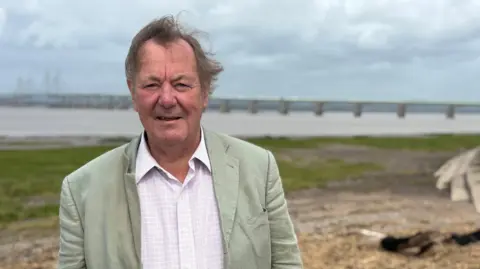'UK should not ignore tidal lagoon recommendations'
 BBC
BBCThe UK should not ignore the potential to generate 2% of its electricity from a tidal lagoon, the author of a commissioned report has said.
The Severn Estuary Commission recommended in March that a lagoon scheme would be the best way to harness tidal power from the River Severn and help the UK reach its net zero goals.
The commission chair, Dr Andrew Garrard, has now said: "If we are going to double our energy generation in 25 years, and it has to be indigenous and it has to be low carbon, how can you possibly ignore a source of energy which is 2% of our needs in one go? It's a slam dunk."
The Department for Energy Security and Net Zero said it is "open to considering well-developed proposals".
The recommendations mark a change from previous reviews that have suggested larger barrage infrastructure should be built across the Severn, but that without formal government support, failed to attract funding.
Lagoon v Barrage
Tidal lagoons are typically loop shaped enclosures which collect water during high tide and release it through turbines to generate electricity.
They are seen as having a lower environmental impact compared with dam-like barrages, which work on the same principal, but span the full width of a river, estuary or bay.
Up to seven previous studies have recommended a barrage structure for the Severn Estuary, all of which have failed to advance due to environmental, political and financial constraints.
Dr Garrard hopes the commission's re-think on how to harness energy created by the Severn might have more success.
"A barrage would be very disruptive to both the Welsh and the English ports, so that's a major commercial consideration," he added.
"It also adds a huge environmental impact, the environment on the Severn is of global significance, so it desperately needs to be protected.
"We really need to build something now and stop having further studies and discussion."

The Severn Estuary is one of the largest in Europe and is one of its most important wildlife habitats, according to the RSPB.
Its saltmarshes and mudflats are used by an average 74,000 birds each winter while its waters support more than 100 fish species and vast numbers of invertebrates.
Following the publication of the report the RSPB welcomed the commission's rejection of a barrage, which it called "environmentally unacceptable".
However it warned "tidal lagoons also present significant risks to nature that have not been overcome so far and must not be ignored".
RSPB Cymru head of nature policy and casework Annie Smith added that while they supported a "rapid transition to renewable energy... this must be achieved in ways that do not further jeopardise our declining wildlife".
Former Labour Welsh secretary Lord Peter Hain was also concerned about the proposals, calling them a very expensive "cop out" in March.
"Lagoons do harness tidal power but... they are very expensive and are a cop out which won't harness the ginormous but untapped natural power of the Severn Estuary," he told BBC Wales at the time.
 Getty Images
Getty ImagesThe River Severn has the second highest tidal range in the world, which reaches 15 metres during spring tides.
A tidal lagoon would cost about £10bn, most of which would have to come from private investment, and could generate at least 2% of the UK's electricity needs each year.
It is estimated it would take up to a decade to become operational, but would last up to 120 years.
"Two per cent might sound like a small number, but it's actually a huge amount of energy," Dr Garrard added.
"So two of those lagoons would be the same as Hinkley Point C [a nuclear power station] just down the coast.
"A lagoon would have at least a 120-year life, [in comparison] a typical power station has 30, and offshore wind farm has 30, Hinkley probably has 60."
The Severn Estuary Commission's report did not look in to specific scheme options or locations, but it is understood the banks of the estuary in Somerset would be a viable place.
Ambition and funding
The UK has so far failed to bring forward any large-scale tidal lagoons, but it is hoped a privately backed Swansea Bay project will be developed in the coming decades.
Meanwhile, the Liverpool City Region Combined Authority is pushing ahead with a tidal barrage across the River Mersey.
Development of the Mersey Tidal Project began in earnest in 2015 and it could be operational by the end of the next decade.
Dr Shaun Benzon, head of project development, said the barrage has been able to progress due to strong local political will.
"We've had an ambition as a combined authority which has been strongly supported by our Mayor, Steve Rotheram," he added.
"By having a key champion behind the project, and also having the ability to fund the development of the project to this phase through our devolved funding we've been able to act ahead of the others."
The UK Marine Energy Council estimate the wave and tidal industries will be worth £50bn to the UK economy by 2050.
In a statement, the Department for Energy Security and Net Zero said it is on a "clean power mission" to "get off the rollercoaster of fossil fuel markets" while "protecting business and household finances with clean, homegrown energy that we control".
"We are open to considering well-developed proposals for harnessing the power of our bays, estuaries and coastlines, which demonstrate value for money", the spokesperson added.
Follow BBC Gloucestershire on Facebook, X and Instagram. Send your story ideas to us on email or via WhatsApp on 0800 313 4630.
